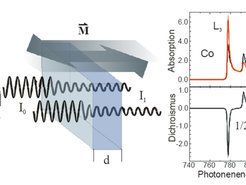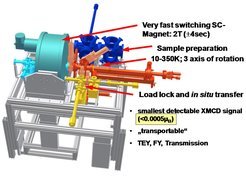X-Ray Magnetic Circular Dichroism (XMCD)

XMCD is one of the key methods for microscopic investigations of magnetic systems, which has been pioneered by the Gisela Schütz in 1987 [G. Schütz et al. PRL 58,(1987) 737]. It is based on the magnetization dependent variation of the X-ray absorption coefficient of circular polarized X-rays present at a vicinity of an absorption edge (see Fig. 1). Is allows in an element specific way the determination of spin and orbital magnetic moments. This provides the determination of the microscopic magnetism of each element present in complex magnetic systems, which is necessary to understand modern solid state magnetic and technological relevant phenomena in a very deep way.Recent scientific results have been performed at magnetic oxide systems, like the ferromagnetic CrO2, halfmetallic Magnetite Fe3O4, Cobaltates, colossal magnetoresistive Manganates, and FePt/FeOx based functional nanoparticles.

In addition methodical developments are an important part of the scientific work in our group. A fast switching 2T magnet systems has been developed, which is constantly improved and optimized for ultra high sensitivity and ultimate signal to noise ratio. For example, in the ZnO:5%Co system, perfectly paramagnetic Co magnetic moments have been quantitatively investigated, despite the very small moments and the dilution based weak signal. A new 8T system is now in use, which allows fast flipping of 7T field in about 10s. This system is stationary positioned at the ANKA/WERA beamline at the KIT in Karlsruhe.
